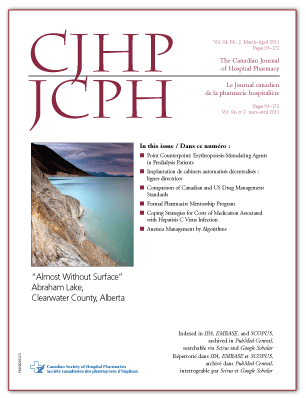Evaluation of Anemia Management by Algorithms in Patients with Chronic Kidney Disease Who Are Not Receiving Dialysis
DOI:
https://doi.org/10.4212/cjhp.v64i2.998Keywords:
erythropoietin, darbepoetin, iron, protocol, anemia, chronic kidney disease, érythropoïétine, darbépoétine, fer, protocole, anémie, insuffisance rénale chroniqueAbstract
ABSTRACT
Background: Anemia commonly develops in patients with chronic kidney disease and is strongly associated with adverse clinical outcomes. There are currently no published studies evaluating the efficacy of a nurse-driven anemia-management protocol for patients with chronic kidney disease who are not receiving dialysis.
Objectives: To evaluate the efficacy of an anemia-management protocol in terms of achieving hemoglobin and transferrin saturation levels within the target range, as well as associated utilization of medications, relative to individualized dosing of medications by nephrologists.
Methods: An algorithm for nurse-driven management of anemia was introduced in April 2009 at a kidney function clinic in a large urban centre. The charts of patients with chronic kidney disease who were not undergoing dialysis were reviewed before (July to December 2007) and after (July to December 2009) implementation of the protocol. Patients' data for hemoglobin, transferrin saturation, and doses of iron and erythropoiesis-stimulating agents were collected for each of the 6-month study periods.
Results: In total, 390 patients were treated for anemia before and 434 patients after introduction of the protocol. The anemia-management protocol was non-inferior to individualized dosing for maintenance of hemoglobin levels within the target range of 110-120 g/L: percentage of measured levels within target range 33.3% (485/1456) before versus 34.2% (504/1472) after (absolute difference 0.9 percentage points, 95% confidence interval [CI] -2.5 to 4.4). The criteria for non-inferiority were not met for maintenance of transferrin saturation within the target range of 22%-50%: percentage of levels within target range 58.8% (374/636) before versus 56.9% (403/708) after (absolute difference 1.9 percentage points, 95% CI -3.4 to 7.2). There were no statistically significant differences in mean doses of epoetin alfa, darbepoetin, or iron before and after introduction of the protocol. Similarly, there were no statistically significant differences in number of dose changes for epoetin alfa, darbepoetin, or iron.
Conclusion: The nurse-driven anemia-management protocol was non-inferior to dosing by nephrologists in terms of managing hemoglobin levels. It would be reasonable to use an anemia-management protocol for patients with chronic kidney disease who are not receiving dialysis.
RÉSUMÉ
Contexte : L’anémie apparaît souvent chez les patients atteints d’une insuffisance rénale chronique et est fortement associée à des résultats cliniques indésirables. À ce jour, aucune étude clinique publiée n’a évalué l’efficacité d’un protocole de prise en charge de l’anémie par les soins infirmiers chez des patients atteints d’une insuffisance rénale chronique non dialysés.
Objectifs : Évaluer l'efficacité d'un protocole de prise en charge de l'anémie quant à l'atteinte des taux visés d'hémoglobine et de saturation de la transferrine ainsi que l'utilisation afférente des médicaments, par rapport à la posologie individualisée prescrite par les néphrologues.
Méthodes : Un algorithme de prise en charge de l'anémie par les soins infirmiers a été mis de l'avant en avril 2009 dans une clinique de néphrologie d'un grand centre urbain. Les dossiers médicaux des patients atteints d'une insuffisance rénale chronique non dialysés ont été analysés avant (de juillet à décembre 2007) et après (de juillet à décembre 2009) la mise en oeuvre du protocole. Les données des patients relativement à l'hémoglobine, à la saturation de la transferrine, et aux doses de fer et des agents stimulant l'érythropoïèse ont été collectées pour chacune des deux périodes de six mois de l'étude.
Résultats : Le nombre total de patients traités pour une anémie était de 390 avant l'introduction du protocole et de 434, après son introduction. Le protocole de prise en charge de l'anémie était non inférieur à la posologie individualisée pour le maintien des taux d'hémoglobine dans la plage des valeurs cibles de 110 à 120 g/L : le pourcentage des taux dans cette plage de valeurs était de 33,3 % (485/1456) avant l'introduction du protocole, comparativement à 34,2 % (504/1472), après son introduction (différence absolue de 0,9 point de pourcentage, intervalle de confiance [IC] à 95 % -2,5 à 4,4). Cependant, les critères de non-infériorité n'ont pas été satisfaits pour ce qui est du maintien de la saturation de la transferrine dans la plage des valeurs cibles de 22 % à 50 % : le pourcentage des valeurs dans cette plage était de 58,8 % (374/636) avant l'introduction du protocole, comparativement à 56,9 % (403/708), après son introduction (différence absolue de 1,9 point de pourcentage, IC à 95 % -3,4 à 7,2). Il n'y avait pas de différences statistiquement significatives dans les doses moyennes d'époétine alfa, de darbépoétine ou de fer avant ou après l'introduction du protocole. De même, il n'y avait pas de différences statistiquement significatives dans le nombre de modifications de la dose d'époétine alfa, de darbépoétine ou de fer.
Conclusion : Le protocole de prise en charge de l'anémie par les soins infirmiers était non inférieur à la posologie prescrite par les néphrologues pour ce qui est de la prise en charge des taux d'hémoglobine. Il serait raisonnable de recourir à un protocole de prise en charge de l'anémie chez les patients atteints d'une insuffisance rénale chronique non dialysés.
Downloads
Downloads
Issue
Section
License
Copyright © Canadian Society of Healthcare-Systems Pharmacy.
After publication of a manuscript in the CJHP, the authors of the manuscript must obtain written permission from the CSHP (publications@cshp.ca) before reproducing any text, figures, tables, or illustrations from the work in future works of their own. If a submitted manuscript is declined for publication in the CJHP, all said rights shall revert to the authors. Please note that any forms (e.g., preprinted orders and patient intake forms) used by a specific hospital or other health care facility and included as illustrative material with a manuscript are exempt from this copyright transfer. The CJHP will require a letter from the hospital or health care facility granting permission to publish the document(s).










